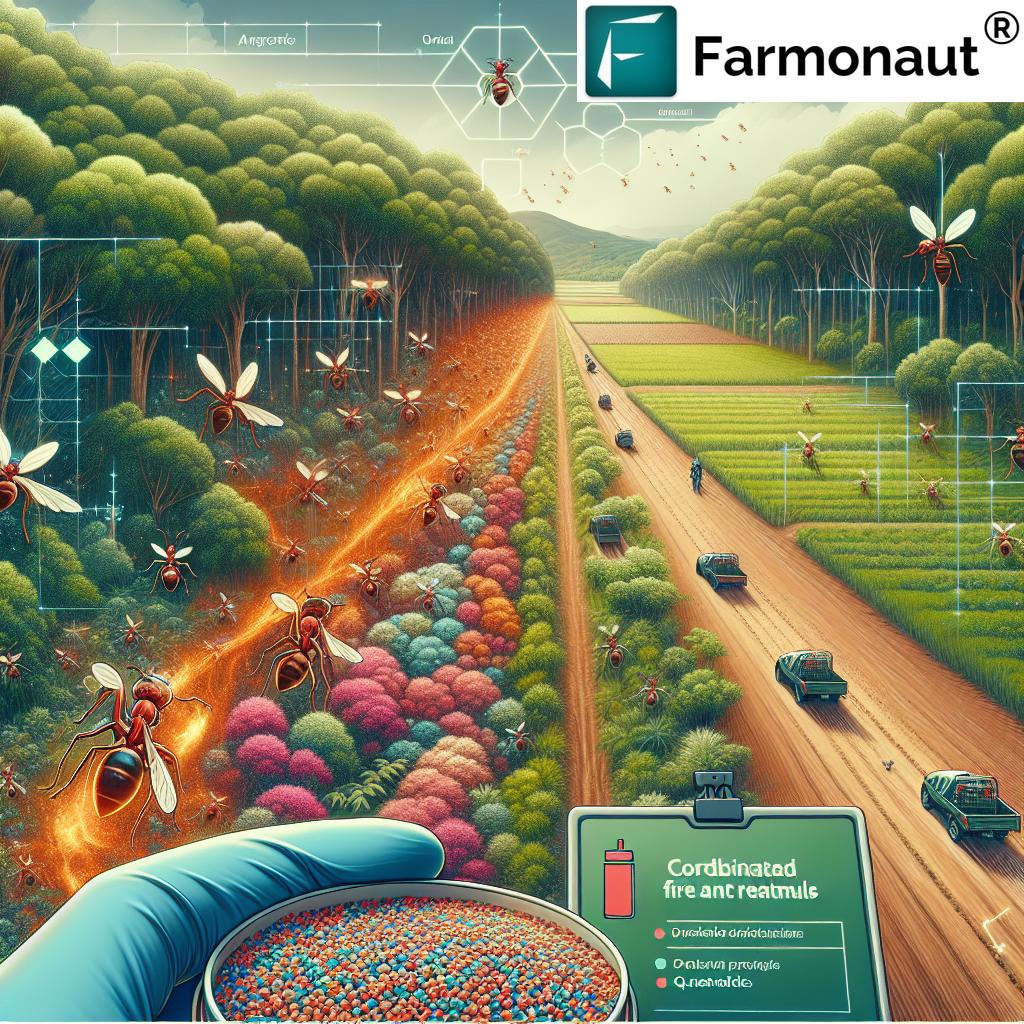Fire Ant Treatment QLD: 7 Powerful Ways to Protect Farms
“Fire ants cause over $1.65 billion in agricultural losses annually in Queensland, impacting crops and native ecosystems.”
Table of Contents
- Introduction
- Understanding the Fire Ant Threat in Queensland
- Impact of Fire Ants on Agriculture and Forestry
- Fire Ant Detection and Early Warning Signs
- Reporting Fire Ants in Queensland: Your Guide to Compliance
- Fire Ant Treatment QLD: 7 Powerful Methods for Eradication
- Comparative Table: Fire Ant Treatment Effectiveness
- Innovative Fire Ant Control Techniques & Technology
- Biosecurity Fire Ants: Obligations and Regulatory Programs
- Protecting Crops and Native Ecosystems: Integrated Strategies
- The Role of Farmonaut in Invasive Species Management
- Fire Ants QLD: Frequently Asked Questions
- Conclusion
Introduction
Fire ants, particularly the red imported fire ant (Solenopsis invicta), represent one of the most devastating invasive pests within Queensland, Australia. Over the decades, these ants have become established across large areas, including South East Queensland, the Sunshine Coast, and agricultural zones extending from coastal to inland regions.
The fire ant eradication challenge is significant; these pests do not only damage crops, livestock, and property—they disrupt agricultural sectors, forestry, and native ecosystems. Their rapid spread threatens our food supply, biodiversity, and even public health.
This comprehensive guide will explain the impact of fire ants on agriculture, explore vital treatment methods available in Queensland, and highlight how coordinated, sustainable, and innovative solutions such as those provided by agtech companies like Farmonaut can empower landholders and producers to combat the threat.
Understanding the Fire Ant Threat in Queensland
Fire ants, originally native to South America, made their way to Queensland through international shipping and trade. The arrival of Solenopsis invicta in Australian shores around the late 20th century marked the start of ongoing invasive species management efforts.
These ants are particularly concerning due to their aggressive nature, ability to inflict painful stings, rapid colony multiplication, and adaptability to varied soil and climate conditions. Colonies can contain hundreds of thousands of ants and become established anywhere materials like disturbed soil, mulch, or hay are present; from urban backyards to productive farmlands, forestry plantations, and beyond.
- Established areas: South East Queensland, Sunshine Coast, rural-urban fringes, and critical farming zones.
- Movement: Often spread via the movement of soil, landscaping materials, potted plants, and agricultural produce.
The fight against fire ants requires both biosecurity vigilance and an understanding of their capacity for damage and structural disruption across multiple sectors.
Impact of Fire Ants on Agriculture and Forestry
Fire ants are omnivorous pests with a broad diet—feeding on seeds, grains, roots, stems, small animals, and insects. In Queensland’s agricultural settings, their potential for damage and disruption is immense:
- Crops and Plants: Fire ants tunnel through soil, roots, and stems, stressing plants and reducing yields. Their activity leads to poor root systems and increased susceptibility to drought and disease.
- Pest Promotion: Fire ants protect pests like aphids for their honeydew, increasing pest pressure and aiding in the spread of agricultural diseases.
- Produce Quality: Direct feeding and root disruption can lower the quality of fruit, vegetables, and grains, resulting in financial losses for farmers.
- LivestockDamage: Fire ants have been known to sting and injure livestock, poultry, and even native and domestic animals, causing stress, decreased productivity, and in severe cases, death among young or incapacitated animals.
- Impact on Native Ecosystems: In natural and forestry settings, fire ants displace and outcompete native ant species and prey on small ground fauna including spiders, lizards, frogs, birds, and mammals. This predation can lead to population declines among valuable and endangered native species.
The impact of fire ants on agriculture and forestry extends beyond immediate economic losses—it disrupts ecological balance, threatens food security, and challenges the sustainability of Queensland’s most vital industries.
Watch: How Farmonaut’s Satellite Technology is Revolutionising Land Use in Agriculture
Fire Ant Detection and Early Warning Signs
Early detection of fire ants is essential for effective management. Left unchecked, infestations can spread rapidly. Here’s what Queensland farmers and landholders must look for:
- Mounds: Dome-shaped mounds (without central holes) 10–40cm high in disturbed soil, grass, or along fencelines.
- Ant characteristics: Workers are reddish-brown, 2–6mm in length, with darker abdomens. Colonies often contain ants of varying sizes.
- Behaviour: Disturbing a nest causes aggressive swarming and multiple stings.
- Property hotspots: Focus on checking paddocks, vegetable beds, machinery yards, hay storage, irrigation channels, newly moved soil, and turf installations.
- Infestation spread signs: Unexplained plant wilt, clusters of reddish ants, dead or stressed young livestock near nests, rapid mound appearance after rain or earthworks.
Consistent inspection and monitoring help prevent surprises. Leverage digital management solutions, like Farmonaut’s crop plantation and forest advisory app, to schedule periodic alerts and mapping of detected hotspots on your property.
Explore: Farmonaut’s Advanced Crop Monitoring & Yield Prediction
Reporting Fire Ants in Queensland: Your Guide to Compliance
Swift and accurate reporting of fire ant infestations is a legal and practical necessity in Queensland. The government’s National Fire Ant Eradication Program relies on timely information from landholders, producers, and the public to coordinate rapid response.
-
How to report:
- Call Biosecurity Queensland on 13 25 23
- Online: Submit a sighting at fireants.org.au
-
Required information:
- Property location and contact details
- Photographs of the ants/nest (if possible)
- Description of mound(s) and surrounding area
- Date and circumstances of detection (e.g., after new soil delivery, observed during farming operations)
Once reported, Biosecurity Queensland deploys expert teams for confirmation, risk assessment, and coordinated treatment. Reporting also ensures compliance with the Biosecurity Act 2014 and protects the broader farming community from further spread.
“Queensland’s fire ant eradication program has treated more than 600,000 properties since its launch in 2001.”
Fire Ant Treatment QLD: 7 Powerful Methods for Eradication
Effective fire ant management in Queensland relies on a combination of treatment approaches. Here are the seven most powerful and widely endorsed strategies for fire ant eradication and control for local producers and landholders:
-
Bait Broadcasting
Widespread application of insect growth regulator (IGR) baits (e.g., S-methoprene or pyriproxyfen) across affected zones. Foraging ants collect and distribute the bait, leading to a colony-wide collapse over weeks.- Recommended for: Large-scale paddocks, cropping land, pasture, and bushland.
- Schedule: Up to three applications per year for 2 years, coordinated with the National Fire Ant Eradication Program.
-
Direct Nest Injection
Application of registered chemical insecticides directly into visible mounds. Rapidly kills most of the colony, but may not eliminate entire nest if queens survive.- Recommended for: Small outbreaks, high-value horticultural areas, yards, and machinery sites.
- Combine with: Broadcasting for complete eradication.
-
Biological Control (Under Research)
Introducing natural enemies such as phorid flies to disrupt fire ant populations is a focus of ongoing research. Phorid flies lay eggs in ants, ultimately killing them.
Currently experimental—watch for future government program updates regarding effectiveness and release plans. -
Physical Barriers and Quarantine
Preventing the movement of soil, mulch, plants, turf, hay, or manure from infested to clean areas. Enforce cleaning protocols for vehicles, equipment, and footwear, especially when moving between properties.- Biosecurity zones mandate strict compliance to restrict material transfer.
-
Hotspot/Spot Treatments
Targeted mound treatments utilizing dusts, surface sprays, or boiling water for isolated outdoor populations in sensitive vegetation or near habitation, as an adjunct to baiting programs. -
Integrated Management Plans
Tailoring self-management action plans, record-keeping, and combining multiple treatment methods to ensure ongoing monitoring and compliance with government-registered protocols.- Support available: The National Fire Ant Eradication Program offers free treatment products and planning assistance to landholders.
- Producers are encouraged to maintain detailed records of all actions.
-
Innovative Aerial & Drone Treatments
Recent advances include using drones and aerial spreaders to distribute fire ant baits across large or inaccessible areas. This allows timely, even coverage, especially in rugged, wetland, or hard-to-reach regions.
Comparative Table: Fire Ant Treatment Effectiveness in Queensland
| Treatment Method | How It Works | Estimated Cost per Hectare (AUD) | Environmental Impact | Efficacy Rate (%) | Time to Results (Weeks) | Sustainability |
|---|---|---|---|---|---|---|
| Bait Broadcasting | IGR baits broadcast over large areas, ants distribute bait throughout the colony | $50–$120 | Low | 80–95% | 6–8 | Yes |
| Direct Nest Injection | Insecticidal liquid injected into visible mounds, rapid kill of main colony | $85–$170 | Medium | 70–85% | 1–2 | No |
| Biological Control | Use of natural enemies (e.g., phorid flies) to infect and kill fire ants | $25–$90 (when available) | Low | 60–80% (projected) | Variable (12+) | Yes |
| Physical Barriers & Quarantine | Restrict movement of infested materials, enforce cleaning protocols | $15–$40 | Low | 55–95% | Ongoing | Yes |
| Hotspot/Spot Treatments | Spot use of dusts, sprays, or boiling water on isolated nests | $25–$60 | Low–Medium | 50–70% | 1–3 | No |
| Integrated Management Plans | Combines chemical, biological, physical, and monitoring strategies | $60–$140 | Low | 85–99% | 6–18 | Yes |
| Innovative Aerial/Drone Treatment | Drones or aircraft apply baits evenly over extensive or difficult terrain | $40–$110 | Low | 80–95% | 6–8 | Yes |
Notes on Table:
- Costs are indicative and vary depending on scale, geography, and product type.
- Sustainability rating factors in environmental risk, long-term efficacy, and compatibility with native ecosystem protection.
- Government assistance and free products may be available for eligible Queensland landholders.
Watch: Satellite & AI-Based Automated Tree Detection for Precise Counting and Location Mapping
Innovative Fire Ant Control Techniques & Technology
The landscape of fire ant detection and control is evolving— technology-driven approaches are essential for sustainable, large-scale biosecurity outcomes. Here are the most significant innovations in the Queensland context:
- Drones and Automated Aerial Treatments: Unmanned aerial vehicles are now routinely used to apply baits over inaccessible wetlands, rough bushland, and large commercial farms. This ensures even coverage and reduces labor costs.
- Remote Sensing & Satellite Imaging: Precise imagery identifies changes in vegetation patterns or heat signatures associated with new mounds, supporting strategic field surveillance. For example, at Farmonaut, we bring large-scale farm management and crop advisories into one platform using satellite data to help farmers track anomalies swiftly.
- AI in Pest Prediction: Artificial intelligence analyzes field data and satellite records, sending proactive alerts to landholders when environmental risk factors (e.g., recent flooding, earthmoving, or new material deliveries) suggest increased fire ant spread or resurgence.
- Blockchain Traceability: Implementing product traceability solutions helps maintain a transparent record of all farm activities, treatments, and produce movements, ensuring compliance with biosecurity regulations and facilitating insurance claims.
Adopting these game-changing technologies empowers Queensland’s producers to stay a step ahead of invasive species, while protecting environmental and commercial interests.
Biosecurity Fire Ants: Obligations and Regulatory Programs
The Biosecurity Act 2014 classifies fire ants as restricted invasive animals in Queensland. Understanding regulatory requirements is critical for all stakeholders, including landholders, contractors, and rural business operators.
- Legal obligations: It is unlawful to move soil, mulch, hay, manure, potted plants, or turf out of established biosecurity zones unless certified as safe. Non-compliance attracts severe penalties.
-
Biosecurity zones:
- Regularly review zone maps and guidelines published by the Queensland Government.
- The National Fire Ant Eradication Program provides zone-specific control strategies and enforces movement restrictions.
- Industry compliance: Producers must maintain treatment and movement records, develop management action plans, and provide staff and contractors with biosecurity induction.
Fire ant management is a shared responsibility. Regular updates from government and industry bodies should inform your operational plans, supply chain decisions, and risk management strategies.
Watch: Farmonaut’s Tech Advancements in Q3
Protecting Crops and Native Ecosystems: Integrated Strategies
Given the multi-faceted impact of fire ants on agriculture and ecosystems, no single solution suffices. Integrated pest and invasive species management protocols prioritise both farm productivity and environmental protection:
- Planner’s Approach:
Combine planned baiting, direct nest treatments, movement controls, and regular biosecurity reviews for your property. - Buffer and Habitat Zones:
Preserve native vegetation and establish clean zones to reduce invasion risk to important crops and pasture. - Precision Monitoring:
Utilise digital mapping and crop health tools, like those available from Farmonaut, to log infestations, schedule inspections, and analyse risk from new earthworks or incoming materials. Our solution provides carbon footprinting to evaluate the environmental impact of every management action and ensure sustainability. - Community Action:
Join local fire ant awareness campaigns, report all suspect activity, and participate in coordinated eradication efforts. Shared vigilance enhances results. - Continued Education:
Stay updated on innovative treatment products, new regulatory requirements, and high-risk periods via Biosecurity Queensland and support platforms.
Farmers and landholders play a direct, ongoing role in protecting crops from fire ants while safeguarding Australia’s unique flora and fauna.
The Role of Farmonaut in Invasive Species Management
At Farmonaut, we recognise that fire ant management and overall invasive species management require a holistic, technology-driven approach paired with robust biosecurity and community participation. Our platform champions affordable, real-time precision agriculture to assist farmers, agribusinesses, and government stakeholders in fire ant detection, compliance, and sustainable treatment planning.
- Satellite Health Monitoring: Our system provides landholders with up-to-date satellite-derived crop health data (NDVI), soil moisture analytics, and risk alerts. Early anomaly detection improves the odds of early fire ant identification.
- AI-Powered Advisory (Jeevn AI): Delivers real-time diagnostics and management strategies, tailored to on-ground data and changing weather, empowering everyone from owners to contractors with actionable advice.
- Resource and Fleet Management: The fleet management module gives large farms and forestry businesses the capacity to track equipment, prevent cross-contamination, and coordinate timely response to reported threats.
- Carbon and Environmental Tracking: With carbon footprint tracking, we provide clarity on emissions reductions linked to chemical use, equipment operation, and land management decisions.
- Blockchain Traceability: Our system ensures transparency for audited produce and material movement by providing blockchain-based traceability—from field to consumer (learn more).
- Access to Ag-Insurance & Loans: Satellite-based verification speeds up loan approvals and insurance claims, promoting risk sharing and investment even during invasive pest crises.
Discover our various affordable subscription plans for Queensland and global users:
For full feature access, activate your Farmonaut account today!
Fire Ants QLD: Frequently Asked Questions (FAQ)
What are the first signs of fire ant infestation on Queensland farms?
How should I report fire ant activity?
Can I use chemical treatments without government involvement?
What are the most effective fire ant treatment methods?
Which materials present the greatest fire ant spread risk?
How does Farmonaut help manage fire ant risks?
Conclusion: Fire Ant Treatment QLD—A Collective Effort for Sustainable Futures
Fire ants pose an ongoing, significant threat to Queensland agriculture, forestry, and ecosystems. With their ability to adapt, spread, and disrupt, there is no one-size-fits-all solution. Instead, eradication and management must be a shared, concerted effort among producers, landholders, government, and technology solution providers.
- Early detection, rapid reporting, and timely treatment—these actions remain at the heart of sustainable fire ant management.
- Integrated treatment plans using bait broadcasting, direct nest interventions, biological controls (as they become available), quarantine, and innovative drone/aerial solutions are crucial for the long-term health of Queensland’s agricultural sectors.
- Leveraging technology—from satellite monitoring to blockchain traceability—enables smarter, safer compliance, and reporting while reducing the environmental impact of invasive species management.
At Farmonaut, our mission is to make precision farming and resource management affordable and accessible to all farmers, strengthening Queensland’s (and the world’s) resilience to invasive pests like fire ants—for a safer, more productive, and sustainable tomorrow. To explore how our services can help you protect your farm and support sustainable agriculture, create your Farmonaut account or learn about our carbon footprinting & compliance solutions today!






















